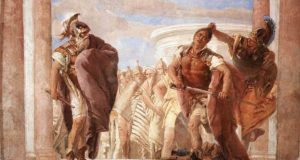AMATA
The wife of King Latinus and mother of Lavinia, who, when Aeneas sued for the hand of the latter, opposed him, because she had already promised Lavinia to Turnus.
At the same time she was instigated by Alecto, who acted according to the request of Juno, to stir up the war with Turnus. This story fills the greater part of the seventh book of Virgil’s Aeneid.
When Amata was informed that Turnus had fallen in battle, she hung herself. (Virg. Aen. xii. 600; Dionys. i. 64.)
ANCUS MARCIUS
The fourth king of Rome, is said to have reigned twenty-three or twenty-four years, from about b. c. 638 to 614.
According to tradition he was the son of Numa’s daughter, and sought to tread in the footsteps of his grandfather by reestablishing the religious ceremonies which had fallen into neglect. But a war with the Latins called him from the pursuits of peace.
He conquered the Latins, took many Latin towns, transported the inhabitants to Rome, and gave them the Aventine to dwell on. These conquered Latins, according to Niebuhr’s views, formed the original Plebs. (Dict. of Ant. s.v. Plebs.)
It ia related further of Ancus, that he founded a colony at Ostia, at the mouth of the Tiber; built a fortress on the Janiculum as a protection against Etruria. and united it with the city by a bridge across the Tiber ; dug the ditch of the Quirites, as it was called, which was a defence for the open ground between the Caelian and the Palatine; and built a prison to restrain offenders, who were increasing (Liv. i. 32, 33 ; Dionys. iii. 36 – 45 ; Cic. de Rep ii. 18 ; Plut. Num. 21 ; Niebuhr, Hist, of Rome, i p. 352, &c.; Arnold, Hist, of Rome, i. p. 19.)
ANGERONA
Or Angeronia, a Roman divinity, of whom it is difficult to form a distinct idea, on account of the contradictory statements about her.
According to one class of passages, she is the goddess of anguish and fear, that is, the goddess who not only produces this state of mind but also relieves men from it. (Verrius Flace. ap. Macrob. Sat. i. 10.)
Her statue stood in the temple of Volupia, near the porta Romanula, close by the Forum, and she was represented with her mouth bound and sealed up (os obligatum et signatum, Macrob. l. c.; Plin. H. N. iii. 9), which according to Massurius Sabinus (ap. Macrob. l.c.) indicated that those who concealed their anxiety in patience would by this means attain the greatest happiness.
Hartung (Die Relig. d. Röm. ii p.247) interprets this as a symbolical suppression of cries of anguish, because such cries were always unlucky omens.
He also thinks that the statue of the goddess of anguish was placed in the temple of the goddess of delight, to indicate that the latter should exercise her influence upon the former, and change sorrow into joy.
Julius Modestus (ap. Macrob. l. c.) and Festus (s. v. Angeronae deae) give an historical origin to the worship of this divinity, for they say, that at one time men and beasts were visited by a disease called angina, which disappeared as soon as sacrifices were vowed to Angerona. (Comp. Orelli, Inscript. p. 87. No. 116.)
Other accounts state that Angerona was the goddess of silence, and that her worship was introduced at Rome to prevent the secret and sacred name of Rome being made known, or that Angerona was herself the protecting divinity of Rome, who by laying her finger on her mouth enjoined men not to divulge the secret name of Rome.
(Plin. l. c.; Macrob. Sat. iii. 9.) A festival, Angeronalia, was celebrated at Rome in honour of Angerona, every year on the 12th of December, on which day the pontiffs offered sacrifices to her in the temple of Volupia, and in the curia Acculeia. (Varro, de Ling. Lat. vi. 23; Plin. and Macrob. ll. cc.)


